Volume 12 · Issue 2 · March/April 2002 | Download PDF
by Rick Bowers
Cosmesis – the art of making artificial limbs look lifelike – has changed dramatically from the time when a “cosmetic” hand might mean a piece of wood carved into the general shape of a hand until today when artificial hands – with freckles, veins, hair, and even tattoos – look so “real” that many people cannot even distinguish between them and an actual hand.
“Going through airport security takes a little longer now that I wear my LIVINGSKIN ® prosthesis,” says Kim Doolan, marketing and public relations director of Aesthetic Concerns Prosthetics, Inc., the company that makes her prosthesis.” In the past, security guards could see my shiny hook or prosthetic hand covered in vinyl skin and understand immediately that I was wearing an artificial arm. These days, even though I tell them the moment the metal detector rings, they don ‘t believe me. They can’t see that my right forearm and hand aren’t flesh and blood, and they usually have to feel the prosthesis several times before convincing themselves. Then they call over their co-workers and, recently, even the National Guard.”
There are several reasons Doolan’s prosthesis “fools” people, explains Tom Passero, owner and president of Aesthetic Concerns. It is painted to match her left arm and duplicate its subtle variations in color, especially around the knuckles and palm; it was carved especially for her based on an impression of her sound arm; it has acrylic fingernails that have lunulae (half moons) at the base and white tips; and, finally, it has a clear, translucent, outer “skin ” layer that acts like the epidermal layer of natural skin.
Another possible reason the arm looks so real is because she doesn’t try to hide it, Doolan notes. “I know most people won’t notice I’m wearing a prosthesis and that gives me confidence to keep it out in public and not hide it beneath long sleeves or inside pockets. That, in turn, means I walk with a more natural gait with both arms swinging at my sides and feel free to use my prosthesis to help me with various two-handed activities.”
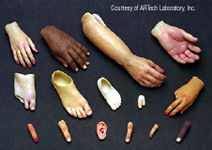 Mike Holt, president of ARTech Laboratory, Inc., another company that makes custom cosmetic prostheses, explains why this is important. “Traditional prostheses have been fabricated primarily to restore motor function with little emphasis on aesthetic appearance,” he says. “In today’s socially oriented society, however, the artificial look of the prosthesis is not acceptable.
Mike Holt, president of ARTech Laboratory, Inc., another company that makes custom cosmetic prostheses, explains why this is important. “Traditional prostheses have been fabricated primarily to restore motor function with little emphasis on aesthetic appearance,” he says. “In today’s socially oriented society, however, the artificial look of the prosthesis is not acceptable.
This is especially true for those in public positions, such as salespersons, physicians, lawyers, office workers, bank tellers, teachers, and secretaries, just to name a few. With all the suffering already endured, it can be devastating for those with limb differences to receive the cruel stares and often-unintentional comments that can destroy their confidence.”
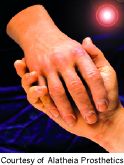 Making the same point almost verbatim, Michael Kaczkowski, president of Alatheia Prosthetics, says Alatheia ‘s Dermatos ® prostheses are designed to simulate the three dermal layers of skin and alleviate this problem as much as possible. Dermatos is the ancient Greek word for “of skin,” and that ‘s what the prostheses appear to be created out of, he says.
Making the same point almost verbatim, Michael Kaczkowski, president of Alatheia Prosthetics, says Alatheia ‘s Dermatos ® prostheses are designed to simulate the three dermal layers of skin and alleviate this problem as much as possible. Dermatos is the ancient Greek word for “of skin,” and that ‘s what the prostheses appear to be created out of, he says.
Though some people with limb differences prefer not to wear a cosmetic prosthesis and argue that it ‘s okay to be different, many amputees would rather blend in than stand out in a crowd. Famed model and activist Heather Mills, for example, still wanted to be as attractive as possible after the amputation of her left leg in 1993.”There are people who say if you have to cover it up, you ‘re not happy with yourself,” she says. “But that ‘s not what it ‘s about – it ‘s about freedom of choice, knowing that you ‘ve got options.
Most of the time I wear my metal, sporty leg, but there are times when I want to go out for a nice meal, wear a short skirt and feel really feminine.” For those occasions, she has an artificial leg that has “toes ” with a natural French manicure.
“Although the first objective of cosmeses is to restore the appearance of injured limbs sufficiently to eliminate the stigma associated with the disfigurement,” ARTech’s Holt says, this does not mean that they are merely for aesthetic reasons and are not functional. “They can also improve the gait and posture, ease lower back pain, relieve pressure on bone spurs and other sensitive areas, protect the tissue from further injury, improve the operation of myoelectric hands, as well as below-knee and above-knee prostheses, and more.”
A world of options
When purchasing a cosmesis, consumers should be aware of the numerous options available today. The various materials and techniques used to make a cosmesis each have advantages and disadvantages that affect the durability, quality, accuracy, level of realism, and price of the final product.
Standard, off-the-shelf, cosmeses, which are made to a variety of standard sizes, are typically made from silicone or Polyvinyl Chloride (PVC) and usually provide only basic details, if any. The advantages of silicone cosmeses are that they are more lifelike, more stain-resistant, more colorfast, more flexible, more resistant to extreme temperatures and sun damage, less likely to cause reactions in the patient ‘s body, and more long lasting than PVC. Silicone cosmeses generally last for years, while PVC cosmeses, due to their tendency to stain easily, will usually need to be replaced in less than six months. The main advantages of PVC cosmeses are that they don ‘t tear as easily as some types of silicone and that they are less expensive, generally costing in the hundreds of dollars.
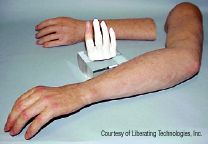 Custom-made cosmeses, which are usually made of some type of silicone of varying degrees of quality, are more expensive (in the thousands of dollars), but offer much greater detail. “If appearance is critical, there is no comparison,” says William J. Hanson, president of Liberating Technologies, Inc., a company that provides both standard production and high-definition custom silicone cosmetic covers for prosthetic limbs. “They can be supplied with extraordinary details, such as freckles, veins, special skin pigmentation, human hair and even tattoos if desired,” he explains. “Females may want to apply nail enamel to their fingernails, and this can be accomplished by substituting acrylic for the silicone nails normally supplied with the covers. The goal is to match the unaffected limb as closely as possible for a natural look.
Custom-made cosmeses, which are usually made of some type of silicone of varying degrees of quality, are more expensive (in the thousands of dollars), but offer much greater detail. “If appearance is critical, there is no comparison,” says William J. Hanson, president of Liberating Technologies, Inc., a company that provides both standard production and high-definition custom silicone cosmetic covers for prosthetic limbs. “They can be supplied with extraordinary details, such as freckles, veins, special skin pigmentation, human hair and even tattoos if desired,” he explains. “Females may want to apply nail enamel to their fingernails, and this can be accomplished by substituting acrylic for the silicone nails normally supplied with the covers. The goal is to match the unaffected limb as closely as possible for a natural look.
“Two methods are used for producing these high-definition silicone covers: creating a clear shell with a painted interior surface or blending pigment into the silicone,” Hanson explains. “Painting the interior surface has been done for a number of years, but more recently, two companies have started blending color into the silicone. This provides a more durable cover because the color is uniform throughout. In addition, it produces natural ‘depth’ of the skin surface.”
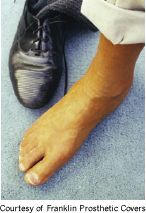 These high-definition cosmeses are expensive, however, and some companies have found a niche between those that offer them and those that offer the standard, off-the-shelf, cosmeses that are inexpensive and offer little detail. Franklin Prosthetic Covers, for example, offers custom-made, seamless silicone covers that are colored to match the patient ‘s skin, but that do not have hair, wrinkles, age spots, and other details. By using color swatches that the company sends them, patients can tell the company which colors to use for the cover. To meet the needs of a diverse population, the company offers 26 standard colors. For realism, patients should specify their “base color,” “suntan color,” and, if they have dark skin, their “palm color.” The patient never has to visit the company.
These high-definition cosmeses are expensive, however, and some companies have found a niche between those that offer them and those that offer the standard, off-the-shelf, cosmeses that are inexpensive and offer little detail. Franklin Prosthetic Covers, for example, offers custom-made, seamless silicone covers that are colored to match the patient ‘s skin, but that do not have hair, wrinkles, age spots, and other details. By using color swatches that the company sends them, patients can tell the company which colors to use for the cover. To meet the needs of a diverse population, the company offers 26 standard colors. For realism, patients should specify their “base color,” “suntan color,” and, if they have dark skin, their “palm color.” The patient never has to visit the company.
“The material is stable against chemical and photo-oxidation attack, is resistant to staining, will not absorb moisture, and has very high tear-strength,” says the company’s president, James G. Stuart. “It’s elasticity makes donning and doffing easy and allows good movement of the underlying prosthesis.”
Alatheia Prosthetics ‘ Derma~flex ™ “skin ” covers also fit into this niche. These silicone covers for lower-extremity prostheses were engineered to be very affordable, have actual skin detail with the option of custom toes, and come in two elastic sizes. “Patients can just stretch them on and go,” says Kaczkowski. “They don ‘t require glue or a heat gun to fit.”
Companies offering these products compete by offering higher quality than off-the-shelf cosmeses and by offering lower prices than those for more detailed cosmeses, explains Stuart, of Franklin Prosthetic Covers.
Other materials and techniques
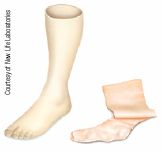 In addition to silicone and PVC, other materials are used to make cosmeses. New Life Laboratories, a division of Kingsley Manufacturing Co., for example, offersNew Skin ,a cosmetic urethane “skin ” finish for prostheses that may be applied either by spraying or brushing. “Once applied, this finish provides a durable, waterproof urethane protective coating that is easy to clean and, when applied over a foam cover, has the texture and feel of actual skin,” says the company ‘s president, Jeff Kingsley. “It is available in three standard shades that may be tinted to match most natural skin tones, and features, such as freckles or the appearance of hair, may be applied with the available tinting kit.”
In addition to silicone and PVC, other materials are used to make cosmeses. New Life Laboratories, a division of Kingsley Manufacturing Co., for example, offersNew Skin ,a cosmetic urethane “skin ” finish for prostheses that may be applied either by spraying or brushing. “Once applied, this finish provides a durable, waterproof urethane protective coating that is easy to clean and, when applied over a foam cover, has the texture and feel of actual skin,” says the company ‘s president, Jeff Kingsley. “It is available in three standard shades that may be tinted to match most natural skin tones, and features, such as freckles or the appearance of hair, may be applied with the available tinting kit.”
The company also offers “a prefabricated, pull-on protective and cosmetic below-knee leg covering” called New Skin Complete. “Made with the New Skin applied to a cosmetic hose, New Skin Complete provides a durable, waterproof urethane skin that is available in seven natural-looking shades,” Kingsley says.
Prosthetics Research Specialists, Inc., is another company that uses different materials and methods. The company produces “skin” by spraying a vinyl or urethane solution onto a foam cover or by pulling a removable “skin” sleeve onto it. The company is also looking for innovative ways to make the “skin” look more realistic. One technique they are working on is airbrushing the “skin ” and matching it to a digital photograph of the patient. Stock or custom tattoos can also be added.
Replication techniques
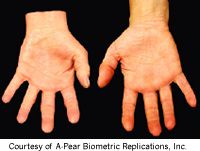 Several companies have devised techniques to ensure that the cosmesis matches the remaining limb. A-Pear Biometric Replications, Inc., for example, makes extremely lifelike and accurate custom silicone cosmeses for upper-and lower- extremity limbs. By using 3D high- resolution scanning and 3D printing, the company provides a replica, by reversal, of the sound limb. “This is achieved by using precision computer and digital imaging tools for processing each individual to capture and replicate size, true form and the fine details of skin, such as fingerprints,” says the company ‘s president, Thomas Ferrone.”For an exact match, comfort of fit, and quick, easy delivery, we use our patented processes joining the most advanced materials, computer-assisted design and computer- aided manufacturing. A color match is achieved through our custom color matching process based on color calibration and a color confirmation procedure.”
Several companies have devised techniques to ensure that the cosmesis matches the remaining limb. A-Pear Biometric Replications, Inc., for example, makes extremely lifelike and accurate custom silicone cosmeses for upper-and lower- extremity limbs. By using 3D high- resolution scanning and 3D printing, the company provides a replica, by reversal, of the sound limb. “This is achieved by using precision computer and digital imaging tools for processing each individual to capture and replicate size, true form and the fine details of skin, such as fingerprints,” says the company ‘s president, Thomas Ferrone.”For an exact match, comfort of fit, and quick, easy delivery, we use our patented processes joining the most advanced materials, computer-assisted design and computer- aided manufacturing. A color match is achieved through our custom color matching process based on color calibration and a color confirmation procedure.”
Prosthetics Research Specialists, Inc., is currently trying to develop a new method of producing a cosmesis that it hopes will surpass existing methods in accuracy. Currently, the company uses the available CAD/CAM technology as a starting point in their process. After scanning the sound limb with a TracerCAD unit, they then carve a matching limb on a large PDI carver.
Attaching cosmeses
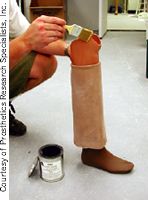 Companies use a variety of methods to hold cosmeses to the prosthetic limb, such as adhesives, suction, and/or form fitting. In some cases, the cosmetic “skin” is sprayed or painted directly onto the artificial limb.
Companies use a variety of methods to hold cosmeses to the prosthetic limb, such as adhesives, suction, and/or form fitting. In some cases, the cosmetic “skin” is sprayed or painted directly onto the artificial limb.
Prosthetics Research Specialists, for example, offers a product called EZ Skin , which is made of tough vinyl and can be brushed or sprayed onto an artificial limb. Afterward, the pigment can be applied to match the patient’s body. The company also offers Stretch EZE Skin ,which was developed especially for above-knee prostheses. This “skin ” is applied directly to a foam cover and will stretch as the prosthesis is bent. The company’s U-FLATE “skin” sleeves are especially interesting. Once the covering is placed over a prosthesis, it is heated and shrinks to fit.
“Individual-and multiple-finger restorations are produced with amazing results,” says Liberating Technologies ‘ Hanson. “Individual fingers normally have a feathered edge to blend with the interface to the hand and are normally attached through a suction fit. Partial hands are fitted to the residual limb on a glove with holes for the remaining fingers. Watches and rings can be used to conceal joints and to divert attention away from the cosmesis.”
Room for improvement
Unfortunately, as good as modern cosmeses are, they do have limitations. They cannot change, for example, as human skin changes during certain activities and with exposure to the sun, Hanson explains.
Though some companies have developed ways to partly solve this issue, none are total solutions. Aesthetic Concerns and Alatheia Prosthetics, for example, offer SeasonGuard and Derma~tan™, respectively, products that temporarily darken the cosmesis and then fade with time to mimic the fading of a natural suntan. The dilemma that remains, however, is how to make the products fade at the same rate as patients ‘ actual tans so that their cosmesis will always match their skin.
Damage to cosmeses is also a major problem. Though many types of cosmeses are stain-resistant and, according to some companies, stain-proof, they are expensive and should be treated with care. Hanson, of Liberating Technologies, advises users to treat them as they would their own hands. “Any of them can be damaged so contact with harsh chemicals, abrasive surfaces, sharp objects and fluids that stain should be avoided,” he says. “When appropriate, rubber or work type gloves should be worn to protect them. When performing work tasks or hobbies that might damage hands and gloves, a powered gripper should be considered as an alternative to the prosthetic hand.” Once the task is finished, the patient can replace his or her cosmesis.
The future
The state of the art of cosmesis is already at an extremely high level. When consumers attend exhibitions where these products are displayed, they will almost always stop to take a second look. It ‘s the kind of reaction people in the cosmesis business are used to.
Though the products and techniques have come a long way, however, there is always room for improvement, and cosmesis-manufacturing companies are always trying to make a better product – one that looks, feels and perhaps even functions just a little more like the real thing.
“I’ve never been one for planned obsolescence,” says Alatheia Prosthetics’ Kaczkowski, expressing the attitude that keeps the industry moving forward.” would like for the expression ‘they don ‘t make things like they used to,’ to be a thing of the past. As a custom fabricator of prosthetics, I’m doing my part to accomplish this.”
The views expressed in inMotion do not necessarily reflect those of the Amputee Coalition or the National Limb Loss Information Center, nor does inMotion endorse any specific technology, company or device. Consumers are urged to consult with their healthcare providers before making any purchasing decisions involving their care.
Companies Mentioned in “The Wonderful World of Cosmesis”
Aesthetic Concerns Prosthetics, Inc.
Phone:800/208-SKIN (7546).
Alatheia Prosthetics
Phone:877/252-8434
Web site: http://www.alatheia.org
A-Pear Biometric Replications, Inc.
Phone:607/363-2915 or 800/492-9993
Web site:http://www.a-pear.net
ARTech Laboratory, Inc.
Phone:888/775-5501
Web site: http://www.artechlab-prosthetics.com
Franklin Prosthetic Covers
Phone:610/666-6645
Web site: http://www.hometown.aol.com/franklinproscov
Liberating Technologies, Inc.
Phone:800/437-0024
Web site: http://www.liberatingtech.com
New Life Laboratories
A division of Kingsley Manufacturing Co.
Phone:949/645-4401 or 800/854-3479
Web site: http://www.oandp.com/kingsley
Prosthetics Research Specialists, Inc.
Phone:800/952-6744
Web site: http://www.oandp.com/products/prs


